Strengthening Taiwan Partnership for the Satoyama Initiative (TPSI), 2018-2020: think global, adapt national, act local
07.07.2021
SUBMITTED ORGANISATION
Forestry Bureau, Council of Agriculture, Chinese Taipei
National Dong Hwa University (NDHU), Chinese Taipei
DATE OF SUBMISSION
07/07/2021
REGION
Asia
COUNTRY
Chinese Taipei
KEYWORDS
national multi-stakeholder partnership network, Taiwan Partnership for the Satoyama Initiative (TPSI), Taiwan Ecological Network (TEN), “think global-adapt national-act local” strategic objectives
AUTHOR(S)
1) Forestry Bureau, Council of Agriculture, Chinese Taipei:
Dr. Hwa-Ching Lin, Director General
Ms. Yu-Chuan Lo, Director of Conservation Division
Dr. Chih-Chin Shih, Chief of Habitat Management Section, Conservation Division, the contact person
Ms. Ya-Ling Chang, Staff of Habitat Management Section, Conservation Division,
2) National Dong Hwa University (NDHU), Chinese Taipei:
Ms. Paulina G. Karimova, PhD Student, NDHU, Specialist Degree in International Relations (Asia Studies), MSc Degree in Environmental Science
Ms. Ya-Hsin Chiu, Research Assistant, NDHU, Joint Bachelor and MSc Degree in Environmental Education and Eco-tourism
*Dr. Kuang-Chung Lee, Associate Professor, NDHU, Chinese Taipei; *corresponding author. In 1989, graduated from the Geography Department, National Taiwan University; from 1991 to 1997, worked for the Council of Agriculture and Taroko National Park, Taiwan; in 2001, got Ph.D. degree in the Geography Department, University College London; currently is an Associate Professor at National Dong Hwa University (NDHU), Taiwan, a commission member of IUCN/WCPA, ICOMOS.
Links
Forestry Bureau Website, Council of Agriculture: https://www.forest.gov.tw/EN (in English)
Webpage of the Satoyama Initiative on the Forestry Bureau Website:
https://conservation.forest.gov.tw/EN/0002040 (in English)
https://conservation.forest.gov.tw/0002040 (in Chinese)
Summary Sheet
The summary sheet for this case study is available here.
Background
Taiwan is a small island with a high population density of average 649 people/km2. The middle and lower reaches of the island are mainly occupied with rural and urban areas. Eighty percent (80%) of the population is concentrated in urban areas which cover only 13% of Taiwan’s total land, while natural and rural areas take up 58% and 29% respectively. Known as one of Four Asian Tigers, starting from mid-1960s, Taiwan experienced an unprecedented industrial development and economic growth, which resulted in its present-day high levels of urbanization, widespread practice of conventional agriculture and substantial land use changes.
In the past, satoyama and satoumi were characteristic of the livelihoods of local and indigenous communities in Taiwan. Environmentally friendly agriculture, forestry, fishery, livestock farming, hunting, and gathering supported by intergenerational knowledge transfer were the key factors that ensured a harmonious balance between humans and nature. However, socio-economic development of the recent decades has led to a pervasive deterioration of Taiwan’s socio-ecological production landscapes and seascapes (SEPLS) causing environmental decline, loss of traditional ethics and culture, disintegration of rural communities, and biodiversity loss.
Since the 1980s, concerns for humans’ “destructive force” have prompted active conservation efforts and establishment of protected natural areas in Taiwan. However there has long been a failure to recognise the role of man-managed agricultural landscapes in biodiversity conservation and environmental protection. Establishing connections between forests, rivers, human settlements, and seas in natural and rural areas of Taiwan has long been in an urgent need for integrated approaches to conservation, revitalisation and sustainability.
Thus, in 2010, introduction of the Satoyama Initiative to Taiwan was viewed as an opportunity to reshape the conservation dialogue and bring the local communities, government agencies and the whole of society into the picture. Since then a wide array of SEPLS revitalization activities has taken place in the name of the Satoyama Initiative and four organizations from Taiwan joined IPSI between 2010 and 2014: National Dong Hwa University (NDHU, 2011), Taiwan Society for Wildlife and Nature (SWAN, 2012), Taiwan Ecological Engineering Development Foundation (EEF, 2013) and Environmental Ethics Foundation of Taiwan (EEFT, 2014).
However, given the diversity of satoyama practitioners and their various backgrounds and objectives, by the end of 2014, the nation-wide promotion of the Satoyama Initiative in Taiwan was facing some challenges, which included:
- The need for a comprehensive policy and strategic planning to connect at the time scattered satoyama-related activities across various themes, localities and stakeholders under the guidance of a government institution;
- The need for knowledge enhancement and academic studies to elicit a comprehensive analysis and discussions of domestic on-the-ground activities as well as to channel Taiwan’s experiences internationally;
- The need for a capacity building mechanism to organise workshops and other kinds of training activities for on-the-ground practitioners to facilitate mutual learning and exchange of experiences;
- The need for good practices in line with the three-fold approach of the Satoyama Initiative in the form of analytical reports on detailed planning processes, management frameworks and implementation outcomes to share with international and domestic audiences.
As a way to address the above challenges, in 2014, NDHU proposed the first draft of the National Strategic Framework for Promoting the Satoyama Initiative in Taiwan. In early 2015, the Strategic Framework of Taiwan Partnership for the Satoyama Initiative (TPSI) was adopted by the Forestry Bureau. This historic moment paved the way for a new chapter in Taiwan’s satoyama story.
Objective and rationale:
Taiwan Partnership for the Satoyama Initiative (TPSI) embodies an integrated approach to solving conservation, revitalization and sustainability issues in Taiwan’s SEPLS by the means of building up a national multi-stakeholder partnership network of like-minded stakeholders and consolidating their complementary strengths and resources for collaborative problem-solving. At a conceptual level, TPSI’s efforts are guided by Aichi Biodiversity Targets (2011-2020) and 2030 Sustainable Development Goals (SDGs), while learning from IPSI, working closely with IPSI Secretariat and on-the-ground partner organizations are the essential parts of TPSI’s action strategy (Figure 1).

Figure 1: Relationship between the Satoyama Initiative, IPSI and TPSI (revised from IPSI Strategy, 2012)
Design of TPSI Strategic Framework is based on IPSI Operational Framework (2010) with its two main targets: addressing issues of SEPLS and formulating solutions, and conservation and revitalization of SEPLS (Figure 2). The well-known formula of “think global, act local” was further elaborated by TPSI to include a third, middle, component – “adapt national”. There are five clusters of activities within the “think global-adapt national-act local” strategic objectives of TPSI Strategic Framework: international participation, policy research, knowledge enhancement, capacity-building, and on-the-ground activities (Table 1).

Figure 2: TPSI Strategic Framework (based on IPSI Operational Framework, 2010)
Table 1: TPSI strategic objectives and five clusters of activities
Think Global
International participation includes a wide range of interactions with the international satoyama partners, such as sharing Taiwan’s experiences
and learning from others at the regional and global IPSI conferences, taking part in activities organized by IPSI (Case Study Reports, Collaborative Activities, Satoyama Development Mechanism (SDM), Satoyama Initiative Thematic Review (SITR)), inviting international satoyama experts
(e.g. from UNU-IAS) to visit Taiwan, and producing publications on TPSI activities to the international readership.
Adapt National
Policy research activities are related to revision of international and domestic policies on eco-friendly agriculture, conservation and rural development practices, and finding ways to promote the Satoyama Initiative, conservation and revitalisation of SEPLS as a part of the national legal framework.
Knowledge enhancement draws on international and domestic theoretical and practical experiences with SEPLS (e.g., SEPLS management and assessment of SEPLS resilience) to adapt this knowledge for policy formulation, capacity-building and on-the-ground activities of TPSI.
Act Local
Capacity building includes a wide range of information sharing, environmental education, skill development activities aimed at the stuff from government agencies (eight district offices of the Forestry Bureau), local communities and general public (with a particular emphasis on the youth). The Forestry Bureau’s official website, “Taiwan Forestry” journal, thematic workshops at selected localities, documentaries, books, and brochures all serve this purpose – aiding the Taiwanese public to better understand and appreciate the value of SEPLS.
On-the-ground activities are workshops, on-site visits and exchanges, seminars, and environmental interpretation events organized with and by the satoyama practitioners – local and indigenous communities, farmers, local schools, non-governmental organizations, and green enterprises. Sharing successful practical examples on revitalisation and conservation of SEPLS, eliciting common and specific problems faced by communities and jointly finding solutions – these are the characteristic features of TPSI on-the-ground activities.
Throughout 2014-2017, TPSI underwent two phases of initial development: 2014-2015 Pilot Project for the Development of Taiwan Partnership for the Satoyama Initiative (TPSI) and 2016-2017 Extension Project for the Development of Taiwan Partnership for the Satoyama Initiative (TPSI), both of which were commissioned by the Forestry Bureau and carried out by NDHU (for more information, please see: https://satoyama-initiative.org/case_studies/facilitating-the-development-of-a-taiwan-partnership-for-the-satoyama-initiative-tpsi-2014-2017/). In 2018, with the aim to enhance the established partnership mechanisms locally and nation-wide, the 2018-2020 Deepening TPSI Communication Project was introduced.
The goals of the 2018-2020 Deepening TPSI Communication Project included: (1) continuing to promote the “think global-adapt national-act local” strategic objectives and five clusters of activities (international participation, policy research, knowledge enhancement, capacity-building, and on-the-ground activities) under TPSI Strategic Framework; (2) integrating and supporting promulgation of Taiwan Ecological Network (TEN, 2018-2021); (3) promoting TPSI with the help of eight district offices of the Forestry Bureau to facilitate the “act local” objective nation-wide.
Activities and results:
Act Local
In 2016, in order to stimulate nation-wide experience sharing and learning about the best satoyama practices from different corners of Taiwan, NDHU and the Forestry Bureau initiated a special type of on-the-ground activities – TPSI Regional Workshops. Since 2018, with establishment of four TPSI Regional Exchange Bases, the Workshops grew into annual two-day events (a total of four each year – one in northern, western, southern, and eastern regions of Taiwan), consisting of on-site visits to SEPLS managed by indigenous and local communities in each region and accompanied by environmental interpretation and education activities and half-day symposiums with experience sharing and discussion sessions.
TPSI Regional Exchange Bases include: TPSI-North (led by Dharma Drum Institute for Liberal Arts, DILA), TPSI-W (led by Endemic Species Research Institute, ESRI), TPSI-S (led by National Pingtung University of Science and Technology, NPUST), and TPSI-E (led by National Dong Hwa University, NDHU) (Figure 3).
Apart from organizing the Workshops and inviting TPSI members from other regions to attend them, TPSI Regional Exchange Bases play an essential role in working with both local and indigenous communities and the government agencies in the area (two district offices of the Forestry Bureau per one TPSI Regional Exchange Base). They often serve as facilitators of dialogue and cooperation between the communities and the government, assist in finding pathways for action and stimulate capacity-building activities within their region.

Figure 3: TPSI Regional Exchange Bases TPSI-N (DILA), TPSI-W (ESRI), TPSI-S (NPUST), and TPSI-E (NDHU) and eight district offices (DO) of the Forestry Bureau
Based on the area of expertise of each TPSI Regional Exchange Base and issues addressed at TPSI Regional Workshops each year, the themes of the Workshops have so far included revitalisation of SEPLS and youth participation (2016-2017), TPSI regional and national networking (2018), intergenerational learning, knowledge transfer and women’s roles (2019), and SEPLS resilience and biodiversity (2020). Production and marketing in SEPLS has been set as a common theme for TPSI Regional Workshops in 2021.
Participants of TPSI Regional Workshops can be divided into seven categories: government agencies, research and academia, NGOs and NPOs, community organisations, green enterprises, farms and agro-parks, and others. The growing interest in the Workshops is apparent from the number of participants over the five years: from 29 organisations in 2016 to 198 in 2020 with the number of seats in each Workshop limited to 35-40 on a first-come-first-serve basis. Majority of participants represent community organisations, NGOs and NPOs, and government agencies, while the number of green enterprises (e.g., farmers’ associations) has also significantly increased over time (Figure 4).


Figure 4: Participant categories of TPSI Regional Workshops in 2016 and 2020

TPSI-N Regional Workshop, September 9-10, 2020

TPSI-W Regional Workshop, November 2-3, 2020

TPSI-S Regional Workshop, September 29-30, 2020

TPSI-E Regional Workshop, September 2-3, 2020
Adapt National
By the end of 2017, it became clear that there was an urgent need for a wider inclusion of ecological, especially biodiversity-related, component into TPSI activities as well as for mainstreaming of the Satoyama Initiative into Taiwan’s national policy. Despite the evident success of promoting the Satoyama Initiative in Taiwan, the Forestry Bureau could not help but point out the dangers of intense land-use change and conventional agricultural practices to the island’s biodiversity. A comprehensive plan to restore fragmented ecosystems, create connectivity between different landscape elements, and promote sustainable resource use was required. Hence, the 2018-2021 Taiwan Ecological Network (TEN) was called upon to accomplish this task.
The 2018-2021 TEN was proposed by the Forestry Bureau as a new cross-sectoral project based on the cooperation between inter-ministerial agencies subordinate to the Council of Agriculture. The main conservation target of 2018-2021 TEN is revitalisation and conservation of Taiwan’s SEPLS in order to achieve the vision of “Living in Harmony with Nature” under the Satoyama Initiative and the Convention on Biological Diversity (CBD).
The three objectives of 2018-2021 TEN include: (1) consolidating the ecological survey data of the previous years to identify the Key Biodiversity Areas (KBAs) in Taiwan, with a special focus is on the KBAs outside the Central Mountain conservation corridor; (2) engaging in protecting and connecting these KBAs (mostly located in low hills and agricultural areas) by the means of eco-friendly agricultural practices under the concept of the Satoyama Initiative; (3) developing east-west wildlife-friendly passages and ecological corridors by the means of rivers, forests and roads to connect important ecosystems between the Central Mountain range and the coastal areas.
The 2018-2021 TEN has been carried out based on its six perspectives (Figure 5): TEN’s blueprint and cross-sectoral platform, the Satoyama Initiative and environmentally friendly production, endangered species conservation, connectivity of animal passages and ecological corridors, native plant restoration and ecological reforestation, and public communication and participation.

Figure 5: Six perspectives of 2018-2021 Taiwan Ecological Network (TEN)
Ten (10) government agencies within the Council of Agriculture system (the Forestry Bureau, Endemic Species Research Institute, Forestry Research Institute, Agricultural Research Institute, Agricultural Research and Extension Stations, Farmland Water Resources Department, Soil and Water Conservation Bureau, the Fisheries Agency, Food and Agriculture Agency, and Fisheries Research Institute) and 10 government agencies outside of the Council of Agriculture system (Construction and Planning Agency of the Ministry of Interior, the Freeway Bureau, Directorate General of Highways, Taiwan Railways Administration, Tourism Bureau of the Ministry of Transportation, Water Resources Agency, Ministry of Economic Affairs, Council of Indigenous Peoples, Executive Yuan, Veterans Affairs Council, National Property Administration of the Ministry of Finance, and Taiwan Sugar Corporation) have taken part in the implementation of the 2018-2021 TEN.
Think Global
As a part of enhancing international cooperation and exchange, the Forestry Bureau and NDHU have been encouraging TPSI partners (eight district offices of the Forestry Bureau in particular) to take an active role in IPSI activities by submitting their Case Studies to IPSI official website, applying for the Satoyama Development Mechanism (SDM) funding and taking part in the Satoyama Initiative Thematic Review (SITR) publications. Between 2018 and 2020, seven new members from Taiwan joined IPSI (Table 2), 11 Case Studies were submitted by Taiwan’s IPSI members, among which two are SDM Projects and two – SITR publications (Table 3).
Table 2: Taiwan’s IPSI members (2011-2020)
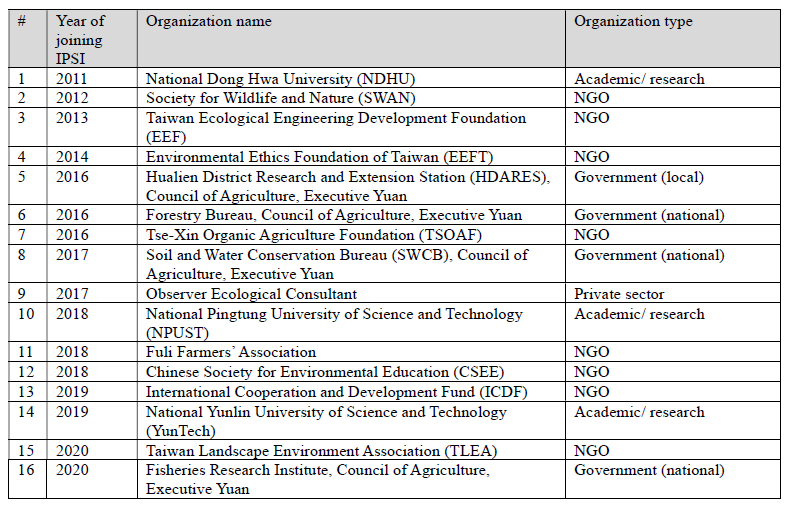
Table 3: Case Studies, SDM Projects and SITR publications of Taiwan’s IPSI members (2013-2020)
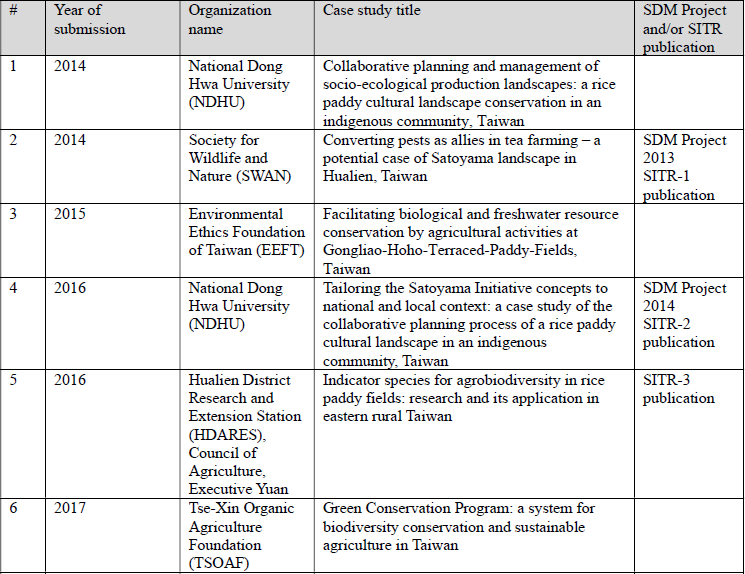

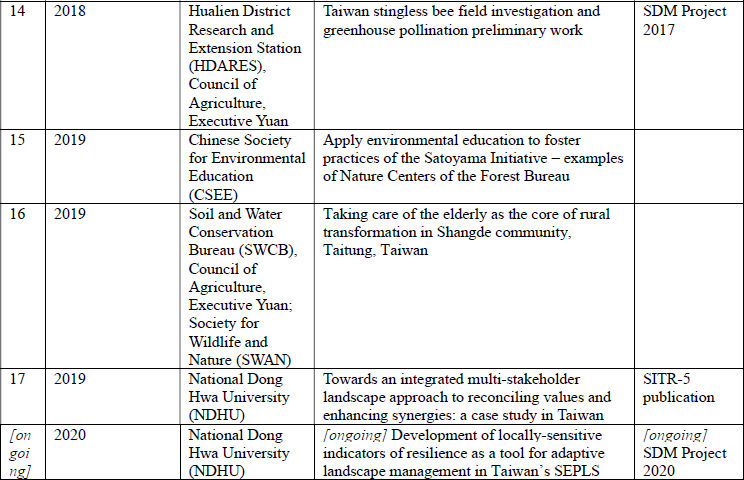
In addition to the activities organized by IPSI, Taiwan’s IPSI members have also started a tradition of their own – Taiwan IPSI Members’ Annual Conference. In August 2019, in preparation for the Global IPSI-8 Conference in Kumamoto, Japan, the Forestry Bureau and NDHU invited all Taiwan’s IPSI members to exchange ideas on jointly representing Taiwan to their international colleagues. Following the 2019 success, they got together again in December 2020 to review and plan Taiwan’s engagement with IPSI, brainstorm potential collaborative activities and post-2020 strategies. With many common themes and pathways for cooperation, this tradition will surely be carried forward in the future.
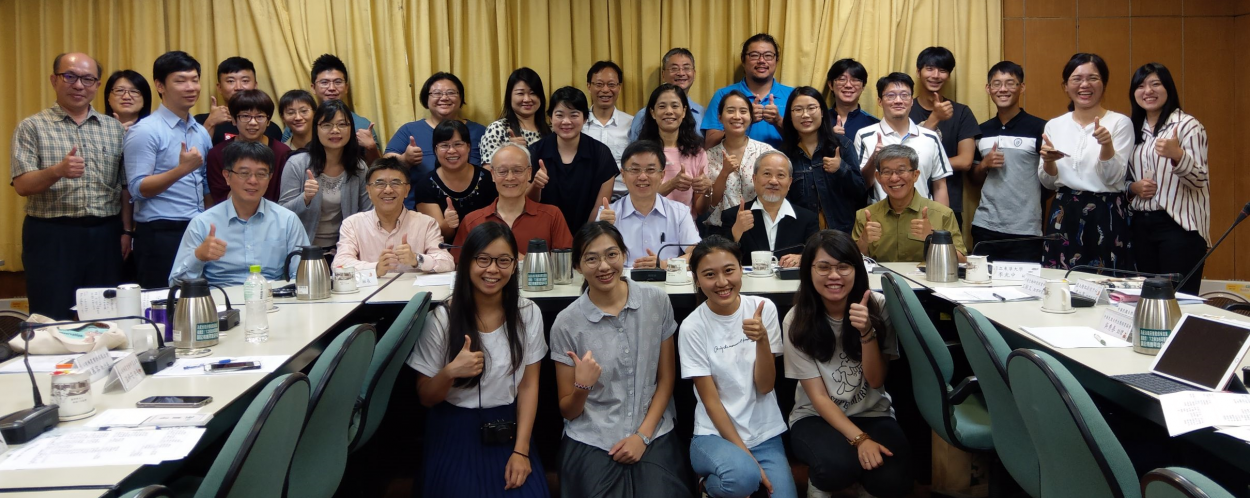
Taiwan IPSI Members’ Annual Conference in 2019, Forestry Bureau Headquarters, Taipei
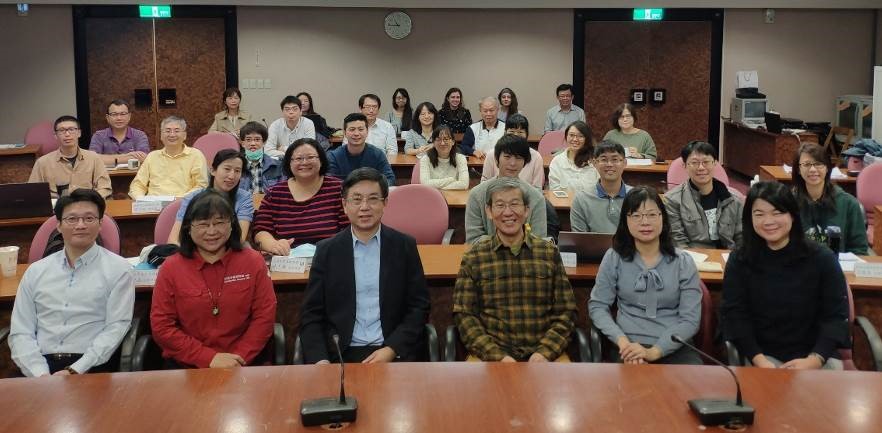
Taiwan IPSI Members’ Annual Conference in 2020, Forestry Bureau Headquarters, Taipei
Lessons learned and key messages:
Successful implementation of TPSI locally, nationally and globally has been possible thanks to the dedicated efforts of its key stakeholders: project supporter and key policy-making authority – the Forestry Bureau, project leader and coordinator – NDHU, Taiwan’s 16 IPSI members (as of December 2020) and non-IPSI members. There is no official membership in TPSI, meaning that any person or organisation interested in implementing satoyama-satoumi-related activities can be a part of TPSI, which has made it into a rather open and numerous network of like-minded partners.
Capacity-building and on-the-ground activities of the “act local” strategic objective are the characteristic features of TPSI. TPSI Regional Exchange Bases play an essential role in working with both local and indigenous communities and the government agencies in the area. They often serve as facilitators of dialogue and cooperation between the communities and the government, assist in finding pathways for action and stimulate capacity-building activities within their region.
Inclusion of the Satoyama Initiative and TPSI into the 2018-2021 TEN has secured a truly nation-wide outreach of TPSI’s “adapt national” efforts. Promulgation of the 2018-2021 TEN has marked a significant shift from traditional protected areas conservation approach towards the one based on recognizing rural areas as a link for restoring the balance between natural and urban systems in Taiwan. It also highlighted a fundamental role that SEPLS play in biodiversity conservation through the promotion of sustainable agricultural practices and revival of rural communities.
An active international engagement of TPSI partners as a part of the “think global” strategic objective has ensured an international recognition of Taiwan’s efforts in promotion of the Satoyama Initiative, biodiversity conservation and rural community development.
Looking ahead for the post-2020 period, TPSI activities of the previous five years (2016-2020) are expected to be further deepened and extended. From the “think global” perspective, TPSI will seek ways to align its efforts with the Global Biodiversity Framework (2021-2030), 2030 SDGs and integrated landscape approaches. At the “adapt national” scale, enhancement of connectivity between TPSI members and themes as well as qualitative and quantitative evaluation of TPSI effectiveness are essential. The “act local” component is in need of a more in-depth problem-oriented approach capable of highlighting common and specific issues faced by Taiwan’s SEPLS and the ways for TPSI to address them.
Further reading
Implementing the Satoyama Initiative for the Benefit of Biodiversity and Human Well-Being: Taiwan’s Experience, Lee KC et al., 2019; online access: https://ap.fftc.org.tw/article/1591
Implementing the Satoyama Initiative for the Benefit of Biodiversity and Human Well-Being, ed. KC Lin and KC Lee, Taipei, Taiwan, 2020; online access: https://www.fftc.org.tw/en/news/detail/676
Realizing Society in Harmony with Nature through Taiwan Partnership for the Satoyama Initiative, Karimova PG. and Lee KC, Taiwan Insight, University of Nottingham, 2019 ; online access: https://taiwaninsight.org/2019/10/09/realising-society-in-harmony-with-nature-through-the-taiwan-partnership-for-the-satoyama-initiative/
The Satoyama Initiative webpage on the Forestry Bureau official website: https://conservation.forest.gov.tw/0002040 (in Chinese); [in English – coming soon]
2018-2021 Taiwan Ecological Network, Forestry Bureau official website: https://www.forest.gov.tw/0002812 (in Chinese)
Authors’ profiles
Dr. Hwa-Ching Lin, Director General, Forestry Bureau, Council of Agriculture, Chinese Taipei
Ms. Yu-Chuan Lo, Director of Conservation Division, Forestry Bureau, Council of Agriculture, Chinese Taipei
Dr. Chih-Chin Shih, Chief of Habitat Management Section, Conservation Division, Forestry Bureau, Council of Agriculture, Chinese Taipei and the Forestry Bureau contact person at IPSI.
Ms. Ya-Ling Chang, Staff of Habitat Management Section, Conservation Division, Council of Agriculture, Chinese Taipei
Ms. Paulina G. Karimova, PhD Student, NDHU, Specialist Degree in International Relations (Asia Studies), MSc Degree in Environmental Science
Ms. Ya-Hsin Chiu, Research Assistant, NDHU, Joint Bachelor and MSc Degree in Environmental Education and Eco-tourism
*Dr. Kuang-Chung Lee, Associate Professor, NDHU, Chinese Taipei; *corresponding author. In 1989, graduated from the Geography Department, National Taiwan University; from 1991 to 1997, worked for the Council of Agriculture and Taroko National Park, Taiwan; in 2001, got Ph.D. degree in the Geography Department, University College London; currently is an Associate Professor at National Dong Hwa University (NDHU), Taiwan, a commission member of IUCN/WCPA, ICOMOS.

